(S2) Limits of Sequences#
In this lesson we are going to see how to:
calculate the limit of a sequence.
determine whether the sequence is convergent or divergent.
Review Videos#
Definition of Limit#
Limit of a Sequence
The limit of a sequence is the number \(L\) such that when we make \(n\) sufficiently large positive, the terms of our sequence \(a_n\) become very close to this number \(L\). We write:
Converges: the sequence is convergent if this limit exists.
Diverges: the sequence is divergent if this limit does not exist.
Graphical Representation#

Limit Laws#
If \(\{a_n\}\) and \(\{b_n\}\) are convergent sequences, then:
Disclaimer: Two of the above limits laws have some extra conditions.
For the power function property, we additionally require \(p>0\) and \(a_n>0\)
For the quotient property, we additionally require \(\displaystyle \lim_{n\to\infty}b_n \neq 0\).
Example 1#
Calculate the following limit:
Solution (Click to see the steps.)
For limits at infinity like this, we start with our \(\tfrac{1}{n}\)-method:
Identify the largest power of \(n\) in the denominator.
Divide each term in the numerator and the denominator by this largest power.
Use the limit laws:
And there we have it!
One thing to notice is that the limit of \(\tfrac{1}{n}\) is one of our \(\tfrac{1}{\infty}\)-forms and so goes to \(0\).
Real Variable Functions#
There is a result that allows us to use all of the techniques for calculating limits at infinity that we developed back when we were talking about real variable functions:
Theorem
Given sequence \(\{a_n\}\), suppose \(a_n=f(n)\) for some real variable function \(f\).
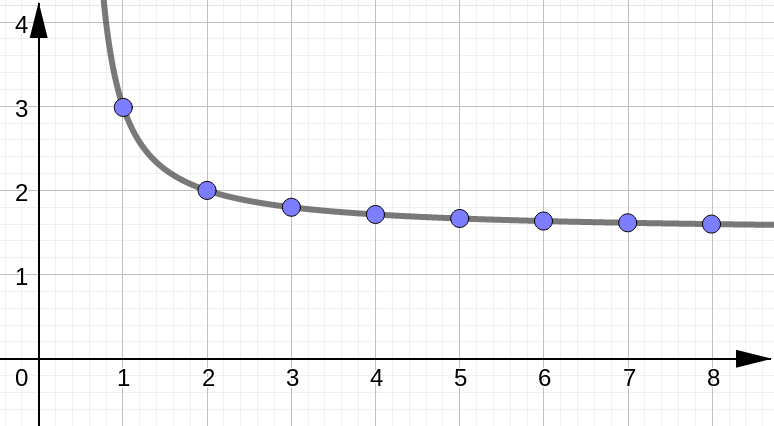
Special Case#
Important Limit
For \(r>0\) we have: \(\displaystyle \lim_{n\to\infty} \dfrac{1}{n^r} = 0 \)
To prove this, we need to relate this sequence to a real variable function:
And then we consider the limit of this real variable function instead:
L’Hospital’s Rule#
Note
If we can relate our sequence back to a real variable function, then we can use L’Hospital’s Rule to help calculate limits, where applicable.
Example 2#
Calculate the following limit:
Solution (Click to see the steps.)
We notice that this is one of our \(\tfrac{\infty}{\infty}\) indeterminate forms, so we want to use L’Hospital’s Rule.
First we need to relate this sequence to a real variable function:
We consider the limit of this function instead:
And there we go! We see that the limit of our sequence is 0 (that final limit is a \(\tfrac{c}{\infty}\)-form and so goes to \(0\)).
Continuity#
As we have seen back in Calculus 1, continuous functions behave very nicely with limits.
Theorem
If \(f\) is continuous at \(x=L\) and \(\displaystyle \lim_{n\to\infty} a_n=L\), then
This result says that when we have a continuous outer function, we can essentially bring the limit inside this outer function and calculate the limit of the terms inside (provided their limit exists).
Example 3#
Calculate the following limit:
Solution (Click to see the steps.)
We begin by observing that the sequence consists of a continuous outer function \(ln (\cdot)\) and some inner terms. We can apply our previous theorem as long we find the limit of those inner terms exists and \(\ln(L)\) is defined.
And since \(\ln 2\) is defined, we can conclude this is ultimately the value of our limit.
Example 4#
Calculate the following limit:
(Click to see the steps.)
We begin by using our usual strategy of dividing each term by the highest power of \(n\) from the denominator. Doing this we get:
We next look at what the denominator and numerator are doing separately as \(n\) goes to infinity.
If we consider the limit of the denominator, we see:
We’re using the continuity of the square root function here to bring the limit inside.
Next we consider the limit of the numerator.
Here we see that as \(n\) gets large positive, so does \(n^{5/2}\). This means we have an infinite limit and we write:
(If the term was becoming large negative, we would write \(-\infty\).)
Going back to the limit:
We see that we have a numerator which is getting large positive and a denominator that is approaching the constant 1. This means the overall fraction must be getting large positive as well and so, goes to infinity.
Therefore we have:
Squeeze Theorem#
Squeeze Theorem
Given sequences such that \(a_n\leq b_n \leq c_n\) eventually holds for all \(n\).
If \(\displaystyle \lim_{n\to\infty} a_n=L=\displaystyle \lim_{n\to\infty} c_n\), then
Motivation for Proof
To see why this might be true, start with the inequality and apply the limit to all sides:
The only way for that last inequality to be true is if
Example 5#
Calculate the following limit:
(Click to see the steps.)
Let’s begin by considering the term \(\cos n\).
On its own, this term is divergent because it oscillates back and forth without ever approaching one specific number. This term is also difficult to work with because the values of the sequence do not fit a nice pattern (other than being points on the cosine curve).
It would be helpful if we could somehow consider an easier sequence, and this is where the Squeeze Theorem comes in.
We start with an inequality that is true for both sine and cosine:
And then try to make the term in the middle look like our original sequence. So we divide all sides of the inequality by \(n^2\) to get:
Now we can apply the limit to all sides:
Remembering \(\displaystyle \lim_{n\to \infty}\tfrac{1}{n^2} =0 \) we get:
And by the Squeeze Theorem, this means:
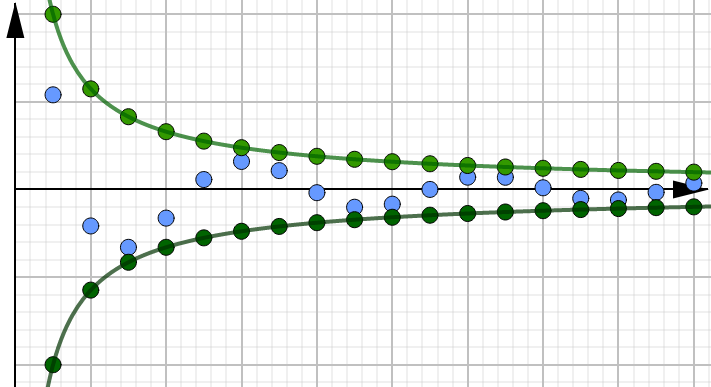
Alternating Sequences#
Consider the alternating sequence:
This sequence is divergent since it alternates back and forth between values \(+1\) and \(-1\), but never actually approaches one specific number.

But what if our sequence had an additional component, besides this alternating term, that shrank as \(n\) approached infinity?
Theorem
If \(\displaystyle \lim_{n\to\infty} |a_n|=0\), then \(\displaystyle \lim_{n\to\infty} a_n=0\)
Example 6#
Calculate the following limit:
(Click to see the steps.)
To see what’s going on with this sequence it may be helpful to rewrite it as:
From here we can see that the \((-1)^n\) term will give us an alternating pattern. But the \(\tfrac{1}{n^2}\) will make everything shrink down to 0.
So to calculate the limit, we first look at the sequence of absolute values:
(The limit is 0, since this is a \(\tfrac{c}{\infty}\) form.)
Applying the theorem, we can conclude that since the limit of the absolute value terms is 0:
the limit of the original sequence must be 0 as well:
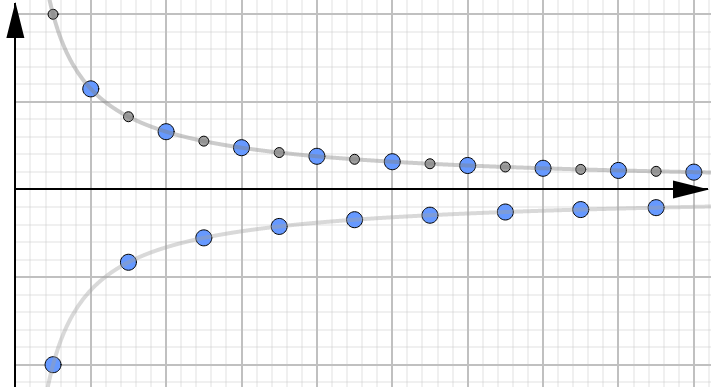
Geometric Sequence#
A geometric sequence is a sequence of the form:
Geometric Sequence
A geometric sequence \(\left\{ a r^n \right\}\) converges when either \(|r|<1\) or \(r=1\) and it diverges for all other \(r\) values.
Positive r-values#
In the graph below, we can see an example of three different geometric series, all with positive \(r\) values.
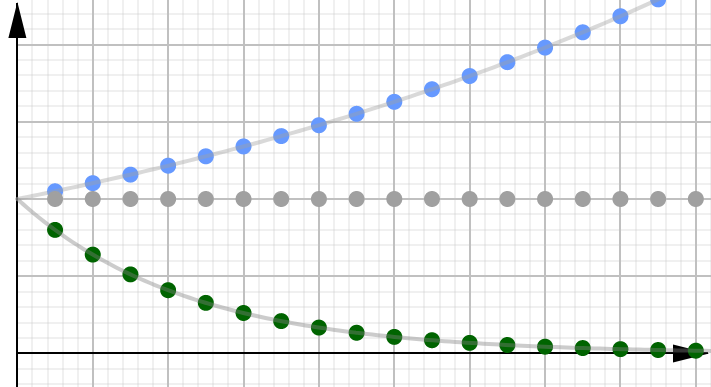
The sequence is on an exponentially growing curve and so the limit goes to infinity.
The sequence is on an exponentially decaying curve and so the limit goes to 0.
(And when \(r=1\), we have the special case where the sequence is constantly 1.)
Negative r-values#
In the next graph, we have an example of three different geometric series, all with negative \(r\) values. And here we see the usual alternating pattern:
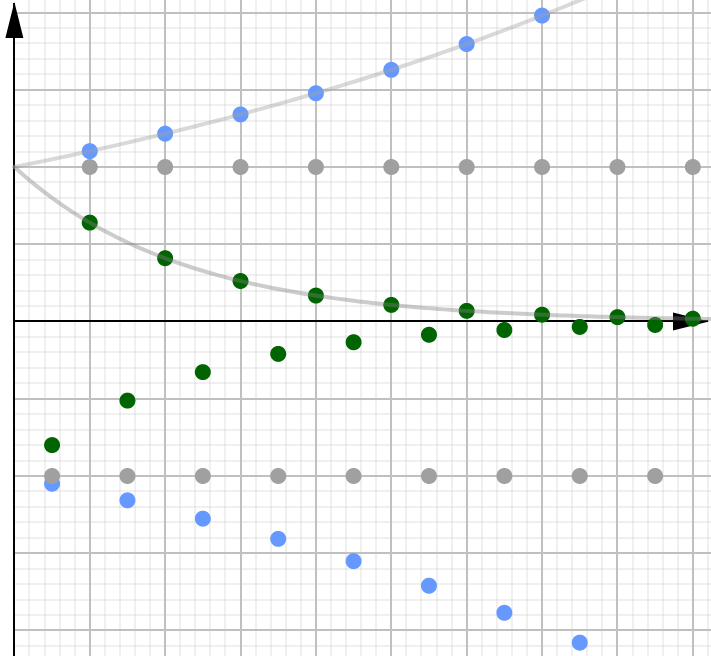
The sequence alternates between points on a curve growing exponentially positive and a curve growing exponentially negative.
The sequence alternates between positive and negative values, but with values that are exponentially decaying towards 0.
Limits#
From all of these different cases we see that:
Example 7#
Calculate the following limit:
(Click to see the steps.)
We see that the terms in the numerator and in the denominator both are being raised to the power \(n\). So our goal is to try and rewrite this as a geometric sequence in the form \(\left\{ ar^n \right\}\)
We want just an \(n\) in the exponent, so that means the \(5^{n+1}\) needs to be broken up:
From here, we can use an exponent law to essentially “factor off” the common exponent:
And here we go!
We have a geometric sequence written in the standard form \(\left\{ ar^n \right\}\), where \(a\) is that constant in front and \(r\) is the number being raised to the power \(n\).
In our case, we see that \(a=\tfrac{1}{5}\) and \(r=\tfrac{-3}{5}\). And since \(|r|=\left|\tfrac{-3}{5}\right|<1\), we conclude that this sequence converges and the limit is 0.
(Note: only the \(r\) value determines whether the sequence converges or not.)
